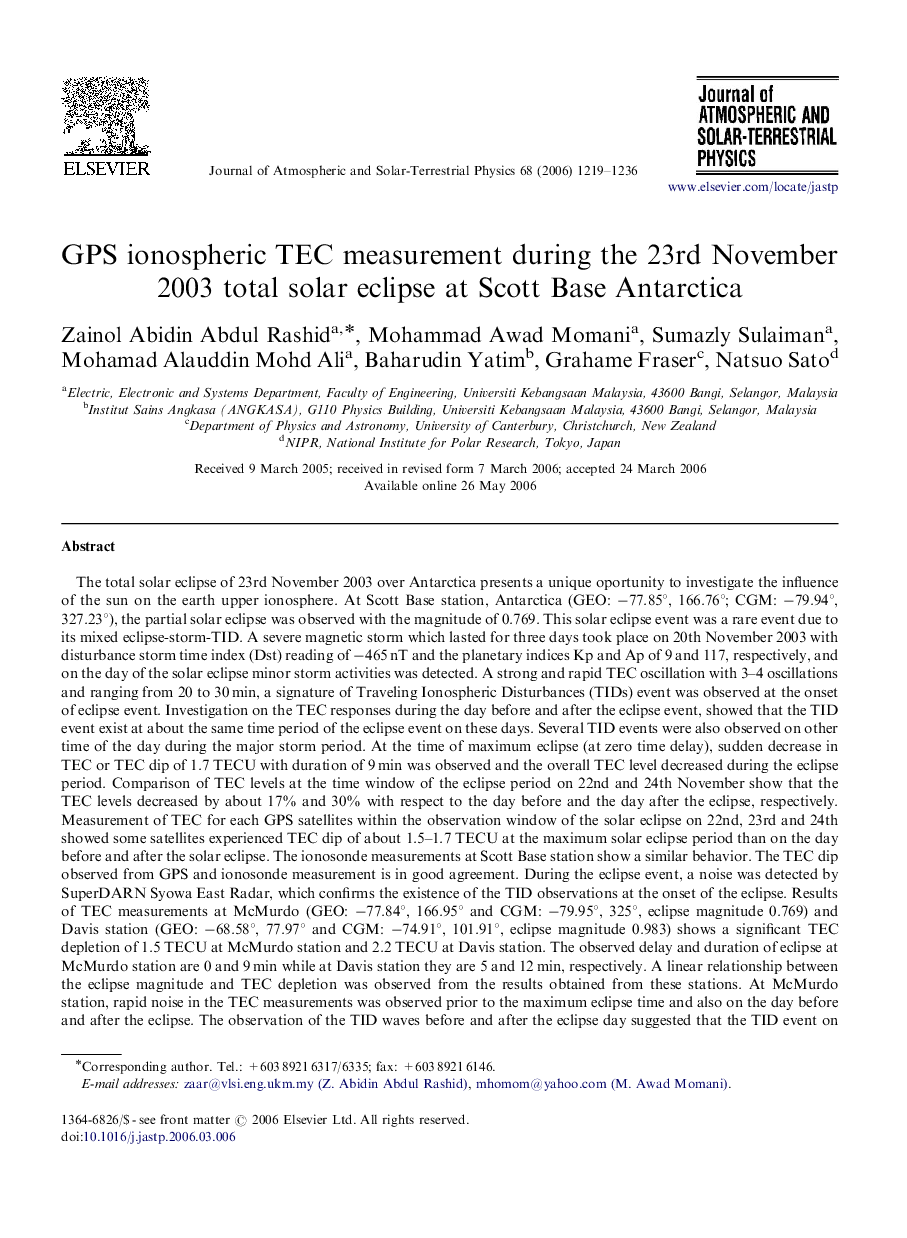| کد مقاله | کد نشریه | سال انتشار | مقاله انگلیسی | نسخه تمام متن |
|---|---|---|---|---|
| 1778383 | 1021802 | 2006 | 18 صفحه PDF | دانلود رایگان |

The total solar eclipse of 23rd November 2003 over Antarctica presents a unique oportunity to investigate the influence of the sun on the earth upper ionosphere. At Scott Base station, Antarctica (GEO: −77.85°, 166.76°; CGM: −79.94°, 327.23°), the partial solar eclipse was observed with the magnitude of 0.769. This solar eclipse event was a rare event due to its mixed eclipse-storm-TID. A severe magnetic storm which lasted for three days took place on 20th November 2003 with disturbance storm time index (Dst) reading of −465 nT and the planetary indices Kp and Ap of 9 and 117, respectively, and on the day of the solar eclipse minor storm activities was detected. A strong and rapid TEC oscillation with 3–4 oscillations and ranging from 20 to 30 min, a signature of Traveling Ionospheric Disturbances (TIDs) event was observed at the onset of eclipse event. Investigation on the TEC responses during the day before and after the eclipse event, showed that the TID event exist at about the same time period of the eclipse event on these days. Several TID events were also observed on other time of the day during the major storm period. At the time of maximum eclipse (at zero time delay), sudden decrease in TEC or TEC dip of 1.7 TECU with duration of 9 min was observed and the overall TEC level decreased during the eclipse period. Comparison of TEC levels at the time window of the eclipse period on 22nd and 24th November show that the TEC levels decreased by about 17% and 30% with respect to the day before and the day after the eclipse, respectively. Measurement of TEC for each GPS satellites within the observation window of the solar eclipse on 22nd, 23rd and 24th showed some satellites experienced TEC dip of about 1.5–1.7 TECU at the maximum solar eclipse period than on the day before and after the solar eclipse. The ionosonde measurements at Scott Base station show a similar behavior. The TEC dip observed from GPS and ionosonde measurement is in good agreement. During the eclipse event, a noise was detected by SuperDARN Syowa East Radar, which confirms the existence of the TID observations at the onset of the eclipse. Results of TEC measurements at McMurdo (GEO: −77.84°, 166.95° and CGM: −79.95°, 325°, eclipse magnitude 0.769) and Davis station (GEO: −68.58°, 77.97° and CGM: −74.91°, 101.91°, eclipse magnitude 0.983) shows a significant TEC depletion of 1.5 TECU at McMurdo station and 2.2 TECU at Davis station. The observed delay and duration of eclipse at McMurdo station are 0 and 9 min while at Davis station they are 5 and 12 min, respectively. A linear relationship between the eclipse magnitude and TEC depletion was observed from the results obtained from these stations. At McMurdo station, rapid noise in the TEC measurements was observed prior to the maximum eclipse time and also on the day before and after the eclipse. The observation of the TID waves before and after the eclipse day suggested that the TID event on the eclipse period cannot be resulted from the solar eclipse, but they could be resulted from the tropospheric origin, however, further investigation is required to examine the sources behind these waves.
Journal: Journal of Atmospheric and Solar-Terrestrial Physics - Volume 68, Issue 11, July 2006, Pages 1219–1236